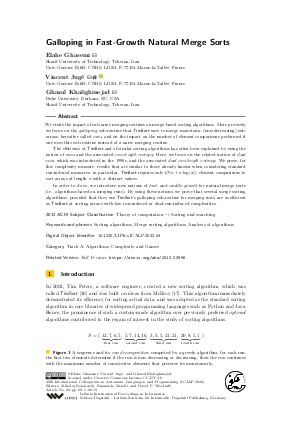Galloping in Fast-Growth Natural Merge Sorts
Authors
Elahe Ghasemi,
Vincent Jugé  ,
Ghazal Khalighinejad
,
Ghazal Khalighinejad
-
Part of:
Volume:
49th International Colloquium on Automata, Languages, and Programming (ICALP 2022)
Part of: Series: Leibniz International Proceedings in Informatics (LIPIcs)
Part of: Conference: International Colloquium on Automata, Languages, and Programming (ICALP) - License:
 Creative Commons Attribution 4.0 International license
Creative Commons Attribution 4.0 International license
- Publication Date: 2022-06-28
File

PDF
LIPIcs.ICALP.2022.68.pdf
- Filesize: 0.9 MB
- 19 pages
Document Identifiers
Related Versions
- Full Version https://arxiv.org/abs/2012.03996
Subject Classification
ACM Subject Classification
- Theory of computation → Sorting and searching
Keywords
- Sorting algorithms
- Merge sorting algorithms
- Analysis of algorithms
Metrics
- Access Statistics
-
Total Accesses (updated on a weekly basis)
0PDF Downloads0Metadata Views
Abstract
We study the impact of sub-array merging routines on merge-based sorting algorithms. More precisely, we focus on the galloping sub-routine that TimSort uses to merge monotonic (non-decreasing) sub-arrays, hereafter called runs, and on the impact on the number of element comparisons performed if one uses this sub-routine instead of a naive merging routine. The efficiency of TimSort and of similar sorting algorithms has often been explained by using the notion of runs and the associated run-length entropy. Here, we focus on the related notion of dual runs, which was introduced in the 1990s, and the associated dual run-length entropy. We prove, for this complexity measure, results that are similar to those already known when considering standard run-induced measures: in particular, TimSort requires only 𝒪(n + n log(σ)) element comparisons to sort arrays of length n with σ distinct values. In order to do so, we introduce new notions of fast- and middle-growth for natural merge sorts (i.e., algorithms based on merging runs). By using these notions, we prove that several merge sorting algorithms, provided that they use TimSort’s galloping sub-routine for merging runs, are as efficient as TimSort at sorting arrays with low run-induced or dual-run-induced complexities.
Cite As Get BibTex
Elahe Ghasemi, Vincent Jugé, and Ghazal Khalighinejad. Galloping in Fast-Growth Natural Merge Sorts. In 49th International Colloquium on Automata, Languages, and Programming (ICALP 2022). Leibniz International Proceedings in Informatics (LIPIcs), Volume 229, pp. 68:1-68:19, Schloss Dagstuhl – Leibniz-Zentrum für Informatik (2022)
https://doi.org/10.4230/LIPIcs.ICALP.2022.68
BibTex
@InProceedings{ghasemi_et_al:LIPIcs.ICALP.2022.68,
author = {Ghasemi, Elahe and Jug\'{e}, Vincent and Khalighinejad, Ghazal},
title = {{Galloping in Fast-Growth Natural Merge Sorts}},
booktitle = {49th International Colloquium on Automata, Languages, and Programming (ICALP 2022)},
pages = {68:1--68:19},
series = {Leibniz International Proceedings in Informatics (LIPIcs)},
ISBN = {978-3-95977-235-8},
ISSN = {1868-8969},
year = {2022},
volume = {229},
editor = {Boja\'{n}czyk, Miko{\l}aj and Merelli, Emanuela and Woodruff, David P.},
publisher = {Schloss Dagstuhl -- Leibniz-Zentrum f{\"u}r Informatik},
address = {Dagstuhl, Germany},
URL = {https://drops.dagstuhl.de/entities/document/10.4230/LIPIcs.ICALP.2022.68},
URN = {urn:nbn:de:0030-drops-164098},
doi = {10.4230/LIPIcs.ICALP.2022.68},
annote = {Keywords: Sorting algorithms, Merge sorting algorithms, Analysis of algorithms}
}
Author Details
- Sharif University of Technology, Teheran, Iran
- Univ Gustave Eiffel, CNRS, LIGM, F-77454 Marne-la-Vallée, France
References
- Nicolas Auger, Vincent Jugé, Cyril Nicaud, and Carine Pivoteau. On the worst-case complexity of timsort. In 26superscriptth Annual European Symposium on Algorithms (ESA), pages 4:1-13, 2018. Extended version available at: URL: https://arxiv.org/abs/1805.08612.
-
Nicolas Auger, Cyril Nicaud, and Carine Pivoteau. Merge strategies: from merge sort to timsort. Research report hal-01212839, 2015.

-
Jérémy Barbay and Gonzalo Navarro. On compressing permutations and adaptive sorting. Theoretical Computer Science, 513:109-123, 2013.

-
Jérémy Barbay, Carlos Ochoa, and Srinivasa Rao Satti. Synergistic solutions on multisets. In 28superscriptth Annual Symposium on Combinatorial Pattern Matching (CPM), pages 31:2-14, 2017.

-
Jon Bentley and Andrew Yao. An almost optimal algorithm for unbounded searching. Information Processing Letters, 5(3):82-87, 1976.

- Josh Bloch. Timsort implementation in java 13, retrieved 01/01/2022. URL: https://github.com/openjdk/jdk/blob/3afeb2cb4861f95fd20c3c04f04be93b435527c0/src/java.base/share/classes/java/util/ComparableTimSort.java.
-
Sam Buss and Alexander Knop. Strategies for stable merge sorting. In 30superscriptth Annual ACM-SIAM Symposium on Discrete Algorithms (SODA), pages 1272-1290, 2019.

- Ben Cohen. Timsort implementation in java 13, retrieved 01/01/2022. URL: https://github.com/apple/swift/blob/4c1d46bc0980d84bf3178bc42295522c242fec86/stdlib/public/core/Sort.swift.
-
Vladmir Estivill-Castro and Derick Wood. A survey of adaptive sorting algorithms. ACM Computing Surveys, 24(4):441-476, 1992.

-
Adriano Garsia and Michelle Wachs. A new algorithm for minimal binary search trees. SIAM Journal on Computing, 6(4):622-642, 1977.

- Elahe Ghasemi, Vincent Jugé, and Ghazal Khalighinejad. Galloping in natural merge sorts. In 49superscriptth International Colloquium on Automata, Languages, and Programming (ICALP), pages 61:1-61:19, 2022. Extended version available at: URL: https://arxiv.org/abs/2012.03996.
-
Te Hu and Alan Tucker. Optimal computer search trees and variable-length alphabetical codes. SIAM Journal on Applied Mathematics, 21(4):514-532, 1971.

-
Vincent Jugé. Adaptive shivers sort: an alternative sorting algorithm. In 31superscriptth Annual ACM-SIAM Symposium on Discrete Algorithms (SODA), pages 1639-1654, 2020.

-
Donald E. Knuth. The Art of Computer Programming, Volume 3: (2nd Ed.) Sorting and Searching. Addison Wesley Longman Publish. Co., 1998.

-
Christos Levcopoulos and Ola Petersson. Sorting shuffled monotone sequences. Information and Computation, 112(1):37-50, 1994.

-
Heikki Mannila. Measures of presortedness and optimal sorting algorithms. IEEE Trans. Computers, 34(4):318-325, 1985.

-
Peter McIlroy. Optimistic sorting and information theoretic complexity. In 4superscriptth Annual ACM-SIAM Symposium on Discrete Algorithms (SODA), pages 467-474, 1993.

-
Ian Munro and Philip Spira. Sorting and searching in multisets. SIAM journal on Computing, 5(1):1-8, 1976.

-
Ian Munro and Sebastian Wild. Nearly-optimal mergesorts: Fast, practical sorting methods that optimally adapt to existing runs. In 26superscriptth Annual European Symposium on Algorithms (ESA 2018), pages 63:1-63:15, 2018.

- Tim Peters. Timsort description, retrieved 01/09/2021. URL: https://github.com/python/cpython/blob/24e5ad4689de9adc8e4a7d8c08fe400dcea668e6/Objects/listsort.txt.
- Clément Renault et al. Timsort implementation in rust, retrieved 01/01/2022. URL: https://github.com/rust-lang/rust/blob/a5a91c8e0732753de7c028182cbb02901fe1b608/library/alloc/src/slice.rs.
-
Olin Shivers. A simple and efficient natural merge sort. Technical report, Georgia Institute of Technology, 2002.

- Guido van Rossum et al. Powersort implementation in cpython, retrieved 01/01/2022. URL: https://github.com/python/cpython/blob/c8749b578324ad4089c8d014d9136bc42b065343/Objects/listobject.c.
- Jeff Weaton and Markus Mützel. Timsort implementation in octave, retrieved 01/01/2022. URL: https://github.com/gnu-octave/octave/blob/7e6da6d504ad962a8d33622b6955b0210ff62365/liboctave/util/oct-sort.cc.
- Simon Zünd et al. Timsort implementation in v8, retrieved 01/01/2022. URL: https://github.com/v8/v8/blob/25f0e32915930df1d53722b91177b1dee5202499/third_party/v8/builtins/array-sort.tq.
